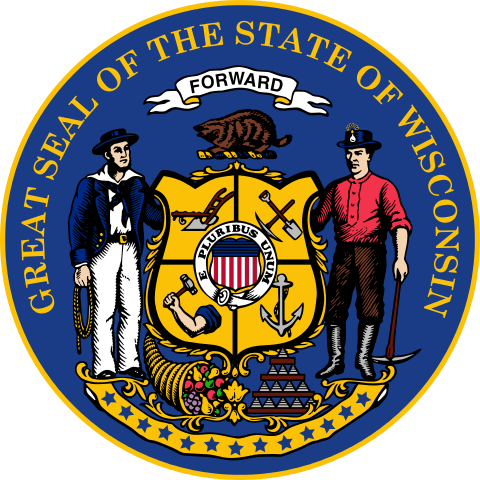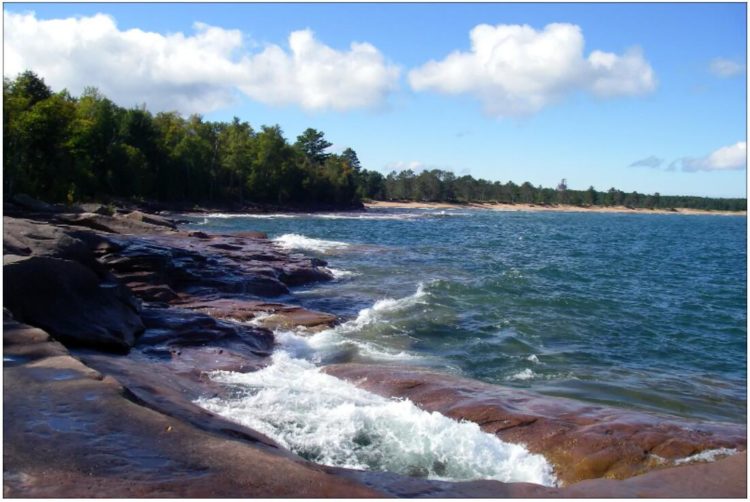Wisconsin is a state in the United States of America. The name Wisconsin is the English version of the French adaptation of a name of the Miami – Illinois for the Wisconsin River meaning “the red lies” (based on the sandstone on the river). Wisconsin’s nickname is Badger State (“badger state”) or America’s Dairyland (“America’s dairy country”). The state bears the latter because of its intensive dairy farming.
| Area | 169,639 km² |
| Residents | 5,778,708 |
| Residents per km² | 34.1 |
| Capital | Madison |
| Postal Code | WI |
| ISO-3166-2 code | US-WI |
| FIPS code | 55 |
Geography
Geographical location
In terms of area, Wisconsin ranks 23rd among the 50 US states with 169,639 km² and is about two and a half times the size of Bavaria. 28,976 km² (17%) of the national territory are water surfaces and 46% are covered by forest. There are around 15,000 lakes and large forest areas in Wisconsin, so that numerous tourists regularly travel from the greater Chicago area to the neighboring state to the north. geographical phwisconsin can be divided into five regions: the northern Lake Superior Lowland comprises an area along Lake Superior. To the south of it join the Northern Highlands, which are characterized by mixed and coniferous forests, including the Chequamegon-Nicolet National Forest and thousands of glacial lakes. Timms Hill, the highest point in the state, is also located here. In addition to fertile farmland, the Central Plains have some remarkable sandstone formations. The state’s largest cities are in the Eastern Ridges and Lowlands in the southeast. The Western Uplands show an alternation between forests and farmland.
Extension of the national territory
Wisconsin is 500 km long between 42 ° 30 ‘N and 47 ° 3’ N and a latitude of 420 km between 86 ° 49 ‘W and 92 ° 54’ W.
Neighboring states
Wisconsin is bordered by Lake Superior and Michigan to the north, Lake Michigan to the east, Illinois to the south, and Iowa and Minnesota to the west.
Climate
The climate of Wisconsin shows hardly any regional differences, partly due to the relatively small height differences within the state. According to Köppen, the southernmost part of Wisconsin is in a humid continental climate with hot summers (Dfa). All other areas of Wisconsin are in the area of the humid continental climate with warm summers (Dfb).
Wisconsin’s summers are warm and sometimes humid; Temperatures above 30 degrees do occur but are not the rule.
Wisconsin’s winters sometimes begin as early as November, when the colorful Indian summer is drawing to a close. Snow often falls in significant amounts across Wisconsin during winter.
Economy
The main line of business is still agriculture. Because of its intensive dairy farming, the state bears the name “America’s Dairyland”. The residents of the country are also jokingly called cheeseheads, so fans of the famous Green Bay Packers football team prefer to wear hats in the shape of a triangular Emmentaler.
But Wisconsin also has a strong industrial economy. Milwaukee became “America’s Toolbox” during the New Deal and World War II. The Kohler plumbing factory is based in Sheboygan, Milwaukee has Harley-Davidson motorcycles as well as Briggs & Stratton lawnmowers, and the bicycle manufacturer Trek has its headquarters in Waterloo.
The real gross domestic product per capita (English per capita real GDP) was USD 53,565 in 2016 (national average of the 50 US states: USD 57,118; national ranking: 20). The unemployment rate was 3.2% in November 2017 (national average: 4.1%).
Wisconsin Flag
The flag of Wisconsin is a blue flag with the Wisconsin seal centered on it.
It was officially designed in 1863 because regiments from Wisconsin wanted a flag for the battlefield. In 1981 the flag was changed; the word “Wisconsin” was inserted at the top and “1848” at the bottom. In 1848 Wisconsin joined the United States as a state.
In the middle, under the lettering Wisconsin and above the year 1848, is the state coat of arms from 1851, which shows a sailor and a miner as a shield holder as symbols of work on land and at sea.
Snow Belt
Snow Belt (English for “snow belt”) is the name of an area around the Great Lakes in the northeast and midwest of the United States of America. In the regions on the southern and eastern banks of the lakes, there is more frequent heavy snowfall in winter. One reason for this is the lake effect snow . Cold winds absorb moisture when crossing the lakes, which then falls in the form of snow on the shore zones. This effect lasts during the winter months as long as the water temperature is higher than that of the air or until the lake freezes over.
The Snow Belt covers parts of the following US states :
- Ohio
- New York
- Indiana
- Michigan
- Wisconsin
Snow conditions similar to those in the Snow Belt can also be found on the west side of Hokkaidō in Japan and Kamchatka in Russia. There, cold winds from the winter highs of Siberia accumulate moisture when crossing the Sea of Japan and the Sea of Okhotsk, which then precipitates over the coasts as slope precipitation.
Also known as Badger State, Wisconsin is short for WI with a population of 5,363,675. The capital city of Wisconsin is Madison and the biggest city is Milwaukee.

